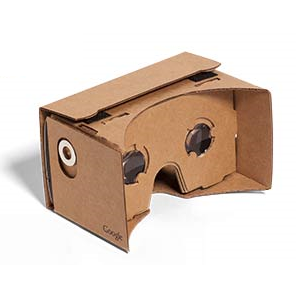I struggled to find time to write this blog – not because I’m too busy at work, but because I’ve been too busy playing with Google Cardboard.
I had heard about Google Cardboard, but I’ve been more interested in Oculus Rift and similar devices and hadn’t given it much thought. Then, much to my surprise, I received a pair (set, maybe? not sure what the accepted term is just yet) courtesy of the New York Times. The pair (that’s what I’m going with) came with my subscription courtesy of GE in Sunday’s paper. Although I was surprised it was included with the paper, the box was clearly marked, so I was quickly aware of what it was. It was in its own packaging and it only took a few minutes to unfold (assemble). An instruction card directed me to download the NY Times virtual reality app (the URL is also printed on the side of the cardboard). The VR app installed quickly and then I was instructed to put my iPhone into the cardboard and enjoy.
Now, just in case you’ve never heard about it, Google Cardboard is a virtual reality (VR) platform developed by Google for use with a fold-out cardboard mount for a mobile phone. It is intended as a low-cost system to encourage interest and development in VR and VR applications.

Here is my takeaway both personally and professionally. Personally, totally dig it. The device itself is, indeed, cardboard, but feels quite sturdy. I’ve used mine quite a bit and while I am generally careful with it, haven’t had any issues with it at all. I didn’t have any concerns about inserting my phone – it feels like it’s held securely – and although I need glasses to see up close, the screen seems in focus. I’m familiar with VR (I’ve written about it before), but hadn’t experienced it via my phone. The VR itself was excellent, but I recognized pretty quickly that this is because of the content. The NY Times had excellent content – both in subject matter and production – available the day I downloaded it. Their app focuses on news stories delivered via immersive video and audio. They brilliantly had a wide range of subjects which enabled me to both watch content that was relevant to me, but also waste time just checking out the different options. I also used it to view an ad – just to continue enjoying the experience.
This wasn’t just my take either – my family all found it cool as did people here at bloomfield knoble.
I think what the NY Times did was an excellent promotional use and one that could be repeated across brands and platforms, with the following challenges:
- It worked because it was delivered to me. If I had to fill out a form or pay for it, I probably wouldn’t have messed with it. I think it’s an excellent promotional handout or direct mail device.
- It was new to me, so I downloaded the app to play with it, but I’m not motivated to download a bunch of other apps to use it. This is actually really good news for the NY Times, because they made me loyal to their app – so anytime I want to show it off or mess around with it, I use their app.
- It’s all about the content. The NY Times content is excellent and also being freshened. If this came with 1 piece of content, I would have tossed it once I got bored. If this were to be used for promotional purposes, it would either have to be a one-off (which is fine sometimes), or it will have to be supported by ongoing content (also fine sometimes).
- It’s still just cardboard. I’m being pretty careful with it now, but because I have no economic value associated with it, I am going to put it in a drawer and it will get damaged or broken. It’s like the cheap pair of sunglasses – you toss those around, but are careful with the pair that cost you money.
- I’m not trained (yet… maybe never). I’m just not sure that I need to get my news via VR. I think that this is more of a content issue, because I might train myself to check the app regularly if it’s something that is experienced much better in VR – like the Royals victory parade, for example. That would be cool. If I know once a week or so that there will be something that is entertaining – I’ll start using it more. For now, just getting news stories, no matter how well done, doesn’t motivate me to regularly check the app.
Now, having said all that, it’s still a job really well done. More than half the battle is getting people to engage with a promotion – in whatever form – and the fact that I took time to assemble the unit, download the app, use the app and then share the experience is the very definition of a successful marketing campaign. And while it sits unused on my desk, it is still on my desk and the app is on my phone.
A STEM (Science / Technology / Engineering / Math) graduate and COO of bloomfield knoble, Thomas exemplifies the view that advertising is becoming an engineering discipline. He leads the integrated insights and strategic planning group in a way consistent with bloomfield knoble’s goal of bringing a strong analytical foundation to uncover fresh and innovative insights and business opportunities.

